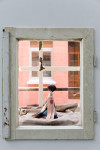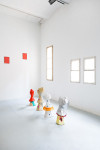






















Daphne Ahlers, Kai Althoff, Heidi Bucher, Anna Haifisch, Nico Ihlein, Mike Kelley, Nora Schultz, Kathrin Wojtowicz
Authentizität. Das Authentisch Unauthentische
The exhibition »Authentizität. Das Authentisch Unauthentische« is a third part of a three-part series which begun in spring 2016 and now end in 2017. While the first part of the series was dedicated to the concept of Fantasy and the second to the concept of Expression, the third focuses on the notion of Authenticity. All three parts are grasped as interrelated aspects of thinking about artistic practice and are based on the attempt to formulate concepts for those moments that interest one in works of art, meaning to positively designate aspects that are met by interest and response, and not only to use a negation to formulate the fact that that quite a bit of contemporary art exhausts itself to a high degree in running through references, in evoking a critical impetus, in a vocabulary schooled in discourse, or in glossy superficiality. Surprisingly, this attempt has brought notions to the fore that are mainly regarded as obsolete and reactionary (Fantasy, Expression, Authenticity). Which is in turn interesting, too, because it seems to reveal a desire to utilize these concepts for contemporary art as well, since they can apparently name something that has to do with the essence and added value of art, meaning something able to generate not only knowledge and experiences, but also intensities. The exhibition series therefore seeks to approach these notions with the awareness of how they are charged and how questionable they are, beyond a clichéd understanding, in order to find out how far and in which direction they can take us. However, the situation has become more complicated in recent years. Against the background of an increasingly stronger criticism of emptied critical or politicized art practices, evoking these moments may not be generally suspected of contributing to a hopelessly antiquated concept of art anymore; but in the wake of the critique of the »political as style« (James Meyer), one must now be careful not to allow a »new inwardness,« an »intensity as style,« to creep in, based on the reactivation of a notion of the autonomy of art restricted to the formal.
The exhibition is by no means intent on prompting the (artist-)subject to be authentic. It is not about defensive identity politics. It neither seeks to put the case for the late-capitalistic imperative of self-expression and self-fulfillment that, by biopolitically exploiting and marketing one’s own liveliness, most obnoxiously converges with the system’s imperative of post-Fordist labor; nor does it open the way for a neo-romantic longing for the genuine, for truth and what is deemed one’s own, which can quickly touch upon reactionary, identitarian ideas and is usually read as a symptom of moments of alienation inherent in postmodern, heterogeneous, and globalized societies.
Authenticity, then, is quite an ambivalent issue, for it raises the question of whether an artistic enunciation that moves both the recipient and the artist, meaning that it makes the offer of becoming involved, is at all conceivable without being tied back to the one who expresses it— to his or her affects, emotions, and intellect. How can artistic production be interesting and relevant without involvement (which is not to be mistaken for narcissism and self-presentation)? What is meant here is expressing oneself, not the exchange of signs based on communication, because things can, of course, be communicated that the one who communicates doesn’t mean, think, or feel. However, this involvement implies knowing that the ‘self’ is present in what one expresses, thus representing a closeness to authenticity. If the concept of authenticity appears to have been disposed of in the theoretical discourses with postmodernism, it is for the reason that the notion of a stable, autonomous, ahistorical self has also proven to be a fiction of modernity. Precisely that to which authenticity would make reference has been lost. For who or what is this ‘self’ supposed to be that expresses itself authentically and is congruent with itself? Today, one merely speaks of authenticity effects, since one cannot feel at home with the fragments of one’s incongruence with oneself. Such a notion would still refer to a substance, connected with the idea of a novel of inner development and thus with that of becoming, of learning and unfolding, of moving from fragment to fragment: Today, I am a different person than tomorrow, and in the best case I will ultimately arrive somewhere by making full use of my potentials.
Although the moment of authenticity is being massively attacked and called into question in theoretical discourses, it is still alive and kicking in other areas, so that in the light of facebook, twitter, and innumerable reality and casting shows, one can speak of downright »authenticity terror« (the title of a symposium at the Deutsches Theater on the occasion of the Autorentheatertage 2012). Authenticity, whether negatively or positively referenced, is therefore highly present, it simply refuses to go away, despite having been the object of permanent critique going back to 1960s structuralism. There seems to be no way around it: For example, when describing a certain photographic expression that doesn’t strategically aim at creating an effect by terming the difference »authentic.« The question therefore arises as to what the concept can achieve, if anything, and on what the surplus value of this difference claimed by descriptions of authenticity is based on.
Even if the postmodern narrative of construction and non-substantiality can be regarded as forming the background of the exhibition and the attendant engagement with authenticity, it is not to be the subject of debate. The issue is not to proclaim a pre-postmodern becoming-one-with-oneself. The question is rather: In which way and in which direction can one think from that point onward? How productive is this discursive status quo of ongoing, inescapable self-alienation? How beneficial is it to permanently regard authenticity only as a phantasm, a »heroic, bourgeois narrative of liberation« (Diedrich Diederichsen)? Doesn’t this merely conceal the next phantasm? And be it that of having recognized the enemy and therefore being in the know? Moreover, what does this theoretical construction imply in practice? Doesn’t the question still remain as to who or what actually expresses when something is expressed, when something like art emerges? What are the sources? What are the points of withdrawal and reference? Isn’t something always referenced, even in a negation? And doesn’t one want to become involved despite the awareness of the construction? Isn’t art-making an extremely ambivalent process in the first place? How much sense does it make when—as Rainald Goetz remarked—discursivity has almost entirely replaced the real? For even if the ‘self’ is a construction, it is still there.
In postcolonial theory, for example, one can find the idea of »strategic essentialism« (Gayatri Chakravorty Spivak), meaning that in order to be able to act in the sphere of practice, in the street, where theory ends, subjects and categories should be determined for strategic reasons, for specific purposes. Something similar could be interesting for artistic practice as well, even if political necessities can’t really be given as grounds: In order to be able to speak, to become or remain capable of acting, one would posit oneself as autonomous, despite the knowledge of one’s conditionality and constructedness. In the wake of such a strategic essentialization, one would then no longer speak of authenticity, but of »strategic authenticity.«
Even if the exhibition starts from an interest in aspects of authenticity, involvement, and being present, it is not concerned with artistic practices that are exhausted in purely acting out immediacy. Here, authenticity is not to be equated with or mistaken for sentimentality, originality, inwardness, or a »tyranny of intimacy« (Richard Sennett), quite to the contrary. The artworks called upon in the show can also be characterized by extreme artificiality and staging, as well as by the rejection of any kind of unmediated artistic enunciation or any gesture that is all TOO artistic. This is occasionally performed with such vehemence and involvement, however, that one can again speak of an authenticimpulse. What is also meant here, then, are narratives aimed at stylization, such as the dandy, the gesture, or the pose, since one can also identify with and authentically embody a role. For this reason, a special focus of the exhibition is on an art that reveals a symbiotic relationship between authentic and anti-authentic moments, while at the same time revealing the attendant border conflicts or bringing them into play in the first place. Even if the artists play with being authentic, with being themselves, they are never fully so. It is never only the self, but it is also never only a role. This attitude of »authentic anti-authenticity« corresponds exactly with what was briefly outlined above as »strategic authenticity.«
These considerations describe but one orientation of artistic practice. They also address a virulent problem of the non-artistic field. The striking feature of our present times is that not only has the call to »Be yourself!« voiced by rock’n’roll and the hippie movement become normative, but also the punk attitude of »Reinvent yourself!« or »Get rid of yourself!«. According to Diederichsen, both are »no longer artistically mediated strategies that show how one can live, how one can assert one’s rights, and how one can respond to the system’s imperatives. They have become imperatives themselves.« Even if there is no right life in the wrong one, if one cannot escape from exploitation, perhaps the play with, or the switching and vacillating between the two positions would be currently the most interesting approach.
Programme
»Members guide« with Cora Althusmann
Wednesday, 14 June 2017, 6 pm
»Heute bin ich anders« – Workshop with Hannah Behringer
Saturday, 17 June 2017, 11am – 1pm
For children and teenagers aged 6 to 14
»Eigen-Arten« – Workshop with Bernd W. Plake
Sunday, 2 July 2017, 2 – 6 pm
For children, teenagers and adults
»Art and Cake « Special
Screening »Räume sind Hüllen, sind Häute" by Heidi Bücher (1981)
Produced by George Reinhart, realisation und camera Lukas Strebel
Sunday, 16 July 2017, 4 pm